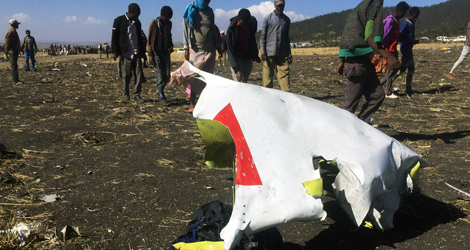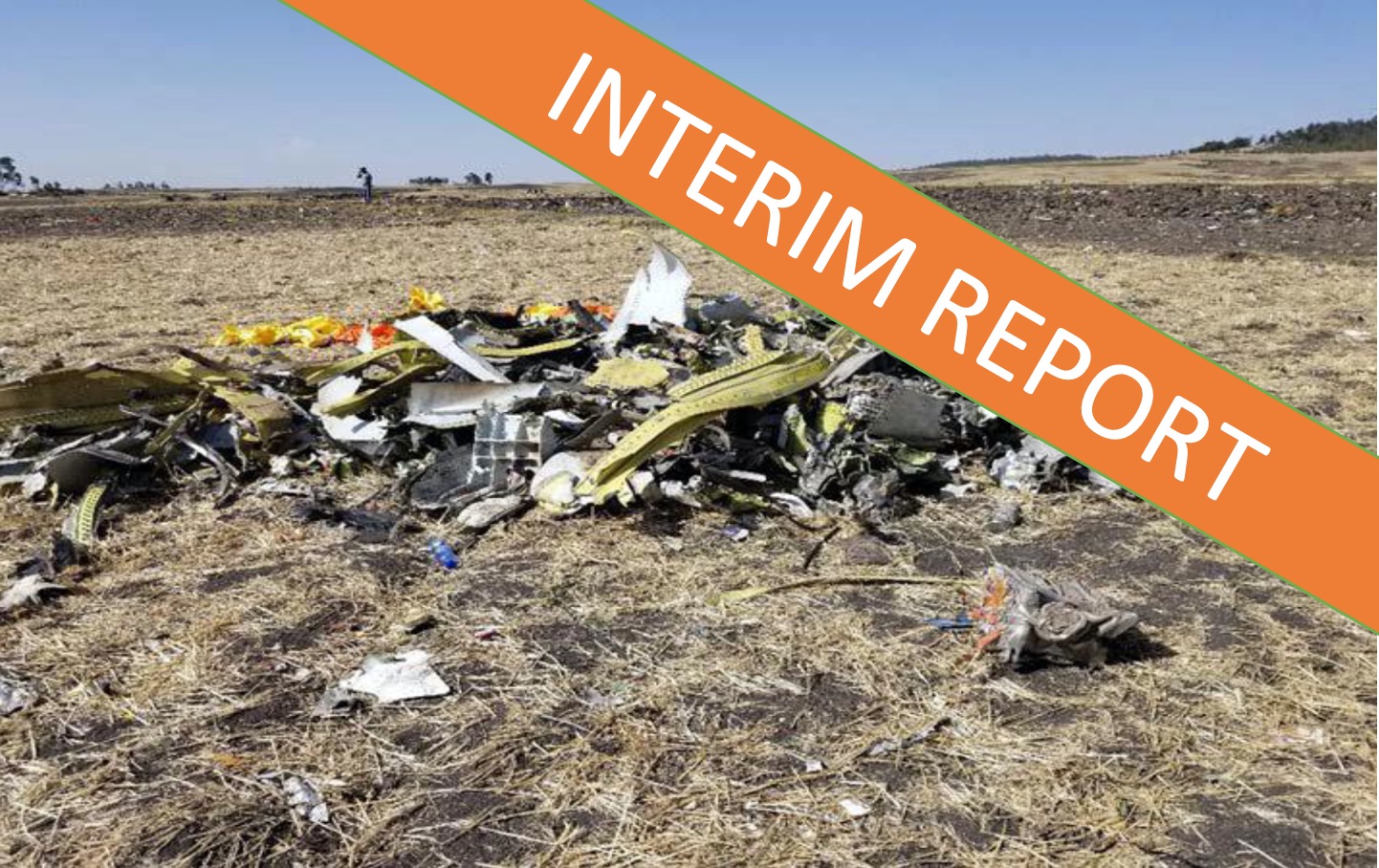Ethiopian Airlines flight ET302 crashed shortly after takeoff from Addis Ababa on March 10th 2019, it was operated with a Boeing B737 Max 8.
Ethiopian Airlines flight ET302 was bound to Nairobi, Kenya Jomo Kenyatta Int. Airport. Shortly after takeoff, the Angle of Attack sensor recorded value became erroneous and the left stick shaker activated and remained active until near the end of the flight.
In addition, the airspeed and altitude values from the left air data system began deviating from the corresponding right side values.
Due to flight control problems, the Captain of Ethiopian Airlines flight ET302 was unable to maintain the flight path and requested to return back to the departure airport.
The crew lost control of the aircraft which crashed at 5: 44 UTC 28 NM South East of Addis Ababa near Ejere village.

INITIAL FINDINGS : On the basis of the initial information gathered during the course of the investigation, the following facts have been determined:
- The Aircraft possessed a valid certificate of airworthiness;
- The crew obtained the license and qualifications to conduct the flight;
- The takeoff roll appeared normal, including normal values of left and right angle-of-attack (AOA).
Shortly after liftoff, the value of the left angle of attack sensor deviated from the right one and reached 74.5 degrees while the right angle of attack sensor value was 15.3 degrees;
- The aircraft has a valid certificate of airworthiness and maintained in accordance with applicable regulations and procedures
- There were no known technical problems before departure.
- The aircraft weight and balance was within the operating limits.
- The takeoff roll and lift-off was normal, including normal values of left and right angle-of-attack (AOA). During takeoff roll, the engines stabilized at about 94% N1. From this point for most of the flight, the N1 Reference remained about 94%.
- Shortly after lift-off, the left and right recorded AOA values deviated. The left AOA values were erroneous and reached 74.5° while the right AOA reached a maximum value of 15.3°.The difference between the left and the right AOA values was 59° and remained as such until near the end of the recording.
- Right after the deviation of the AOA the left stick shaker activated and remained active until the near end of the recording. The pitch Flight Director (F/D) bars disappeared on both left hand and right hand Primary Flight Displays (PFD). As the aircraft crossed 400 ft Radio Altitude the right and left pitch F/D bars appeared again.
- Immediately after the LH AOA sensor failure, the left AOA erroneous values affected the LH FD pitch command, and the RH and LH Flight Director (FD) pitch bars started to display different guidance.
- The Stall Management Yaw Damper Computer -1 (SMYDC 1) computed LH minimum operational speed and LH stick shaker speed greater than VMO (340 kt) without any alert or invalidity detection.Thus; the indicated LH airspeed was inside the minimum speed (red and black) band.
- Approximately five seconds after the end of the crew manual electrical trim up inputs, a third automatic nose-down trim (MCAS) triggered. There was no corresponding motion of the stabilizer, which is consistent with the stabilizer trim cutout switches being in the ‘’cutout’’ position
- The right hand over speed clacker sounded and it remained active until the end of the recording. The RH speed values varied between 360 kt and 375 kt (RH values). On the LH PFD, the LH computed airspeed oscillated between 335 kt and 350 kt.
- Approximately five seconds after the last manual electric trim up input, a fourth automatic trim nose-down (MCAS) triggered. The stabilizer moved from 2.3 to 1 unit. The vertical speed decreased and became negative 3 s after the MCAS activation.
- The difference training from B737NG to B737 MAX provided by the manufacturer was found to be inadequate.
- The AOA Disagree message did not appear on the accident aircraft as per the design described on the flight crew operation manual.
- AOA failure detection feature of the ADIRU did not detect the erroneous AOA from the left AOA sensor because it only considers the value to be erroneous when the AOA value is outside the physical range. Thus; SPD and ALT flag never appeared on the PFD.
- MCAS design on single AOA inputs made it vulnerable to undesired activation.
- The specific failure modes that could lead to uncommanded MCAS activation, such as an erroneous high AOA input to the MCAS, were not simulated as part of the functional hazard assessment validation tests. As a result, additional flight deck effects (such as IAS DISAGREE and ALT DISAGREE alerts and stick shaker activation) resulting from the same underlying failure (for example, erroneous AOA) were not simulated and were not documented in the stabilizer trim and auto flight safety assessment


“The crew performed runaway stabilizer checklist and put the STAB TRIM CUTOUT switch to cutout position and confirmed that the manual trim operation was not working”
The Manual Trim Wheel not working (??) may have been the result of the throttles never set less than 92% power, held there throughout the flight and subsequent crash. The report also states that the “OverSpeed” clatter was heard so the B737 had gone through the Never Exceed speed…such a speed would have placed enormous pressure on the horizontal stabilizer that would have required an extremely high amount of pilot input to control the stab manually. It is not that the manual wheel was inoperable, but was incapable of overturning the speed factor. Also, presumably, the pilots were using the “stick” to pull the nose up while trying to use the manual wheel,then the jackscrew controlling the stabilizer movement was probably jammed and would have required the pilots to relax the pressure on the stick.
6 minute flight time: Quite a bit to absorb in manual flying with a 350 hour copilot getting line training facing such flight control immediate actions that require a high level of experience for good crew resource management.
I have done much research about what might have caused this accident. Most importantly I have found what could have caused the AOA sensors to give confusing data. What I found was that there was an eruption of 2 volcanoes in the Democratic Republic of the Congo earlier that morning and we know that eruptions of volcanoes can cause what we have referred to in the past as tornadoes. I have research and satellite views that shows that Ethiopian Flight ET 302 flew into a vortex created by the eruptions of the 2 volcanoes. Both ash plumbs and vortexes can be seen moving northeast from the volcanoes in the Congo to the accident site. Just think what would happen if a plane flew into a vortex, as modern planes with sweptback wings are unstable in a wind coming from one side or the other? The problem is that the AOA sensors were never designed to account for a plane flying into a vortex. While I have tried to contact Boeing I have not been able to get through to them. Any help in contacting them would be appreciated.